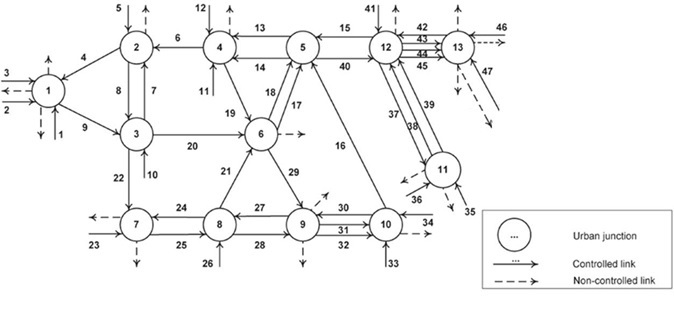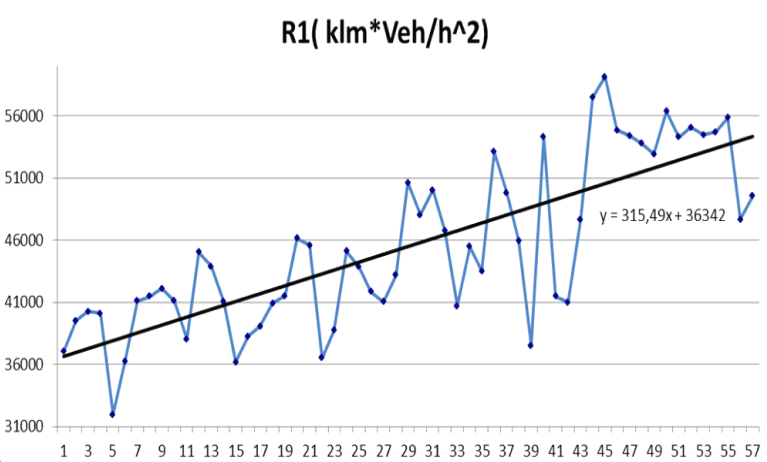Chania Traffic Network
The research leading to these results has been partially funded by the European Commission FP7-ICT-5-3.5, Engineering of Networked Monitoring and Control Systems, under the contract #257806 AGILE.
Test Case Description:
In order to evaluate CAO the Chania city traffic network was used. CAO was responsible for fine-tuning of the control parameters that a local signal control strategy uses. Chania is a touristic city in Crete, Greece, facing serious congestion problems especially during summer period, when its population is practically doubled due to tourists. The overall network, covering a total length of approximately 8 km, comprises of 13 controlled junctions (each consisted by 3 to 5 links) with detector loops typically located either around the middle of the corresponding links or some 40 m upstream the stop-line (see the figures below). Historical traffic flow data for this network from the year 2008 have been used to create a demand scenario, which involves congested traffic conditions. As a result, the large scale test case system can be considered as a highly complex one, involving uncertain situations and dynamics due to its strong dependence on weather conditions and unpredictable human driver behavior. The CAO application presented a great potential in providing efficient traffic management strategies which, besides improved travel times, mean speed, productivity and reduced delay times, affect in a positive manner the communal economical activities (e.g. transportation), vehicle fuel consumption and environmental footprints and also economically boost of the ITS market sector.


While the traditional approach to the control of an urban network involves coordination via common cycle times at all junctions as a minimum requirement, the control approach adopted herein operates without such a constraint. The only constraints respected herein are the prescribed ordered sequence of the signal control stages and their minimum permissible green times, as well as the minimum and maximum cycle times that can be adopted at each junction. More specifically, the signal control approach adopted herein comprises of two low-cost algorithms, which are used to update, once per cycle, the signal control settings, namely the cycle time and the green splits, i.e. the relative green duration of each stage (as a portion of the cycle time), at the local junction level. These two algorithms operate at frequent control intervals (e.g. once per cycle time) in order to respond timely to the random variations of the prevailing traffic conditions.
To update the cycle time, a cycle regulation (CR) algorithm is used that constitutes a variant of the feedback-based control law developed in the frame of the TUC (Traffic-responsive Urban Control) strateg. The CR algorithm modifies the cycle times so as to respond to the prevailing saturation levels. On the other hand, TUC approach is used as a split control (SC) strategy. Note that in all regions/junctions both SC and CR algorithms are locally referring and act in a totally independent manner from the rest.
From the aforementioned two algorithms, the CR one adopts a control law that includes a number of parameters, which affect the intensity of its control reactions, thus its performance and efficiency. More specifically, for cycle time update purposes the following control law is used (see Error! Reference source not found.):

where q is the current control period, C(q) the calculated cycle time [sec], σ(q) the mean value of the space occupancies of some pre-specified links, Cmin the minimum permissible cycle time [sec], and ![]() ,
, ![]() and K1, K2>0 the control parameters, which should be suitably configured to avoid possible degradation of the control performance.
and K1, K2>0 the control parameters, which should be suitably configured to avoid possible degradation of the control performance.
After the application of the control law, C(q) is constrained within the range ![]() with Cmax the maximum permissible cycle time [sec], to become feasible, if necessary. Then, the CR algorithm is applied to split the identified cycle times in the corresponding cycle stages.
with Cmax the maximum permissible cycle time [sec], to become feasible, if necessary. Then, the CR algorithm is applied to split the identified cycle times in the corresponding cycle stages.
Note that as a reference case (Base Case Scenario – BCS) the TASS strategy, a commercial widely used control strategy from SIEMENS, was used as it was also adopted in the control practice of the network.
Cost Function:
The aim of the optimization process is to maximize a representative performance index through a periodic re-tuning of these set of parameters per junction. A performance index commonly used in this respect is the Network Mean Speed (NMS) [km/h]. However optimizing NMS only is not sufficiently enough since the Network Demand (ND) affects heavily the NMS in an approximately disproportional manner; usually varies throughout the day and the period of the year. For this reason, similarly to vehicle-kilometers index, a representative metric – namely Network Productivity (NP) [km∙veh/h2], has been adopted. NP metric considers the multiplication product of Network Mean Speed (NMS) [km/h] and Average Network Demand (ND) [veh/h], so as to “weigh” the NMS improvements in cases where ND is also increased. An estimation of this performance index became available from the measurements provided by the loop detectors of the specific network. Utilizing occupancy and flow measurements, the Network Mean Speed [km/h] and Average Network Demand [veh/h] were calculated so as to finally calculate the Network Productivity (NP) [km∙veh/h2].
Real-Life Results:
The real-life tests took place during summer of 2014 aiming to improve the traffic conditions (i.e. maximize the Network Productivity). As aforementioned, note that the reference Traffic Manament System and its original parameters (i.e., the TMS parameters before their calibration) correspond to a very well-designed TMS, achieving the best the state-of-the-art can offer for the design of TMS for urban road networks. The real-life results after implementing CAO for about 60 days (see the Figure below), indicate that CAO was able to provide with 40-50% improvements over a well-designed TMS. The improvements have been calculated based on the productivity index (the mean speed achieved inside the network multiplied by the traffic demand). Conservative calculations based on the above-mentioned improvements in the city of Chania, indicate that CAO leads to annual fuel cost savings of around 1-2 Million Euros for an urban area of 100,000 people.

After 60 application days, CAO achieves improvements between 40-50% with respect to a well-designed reference control strategy. Such improvements can be quantified to annual fuel cost savings of around 1-2 Million Euros for an urban area of 100,000 people.

